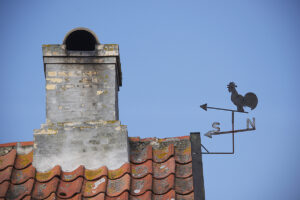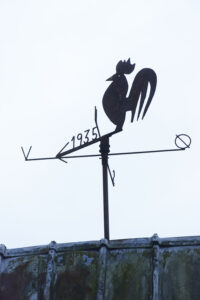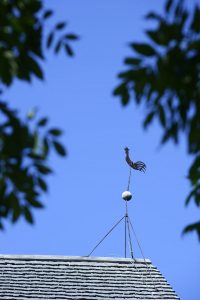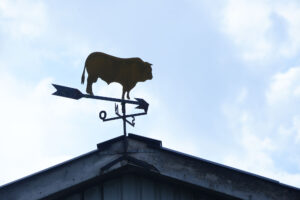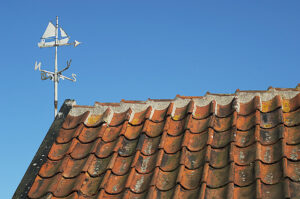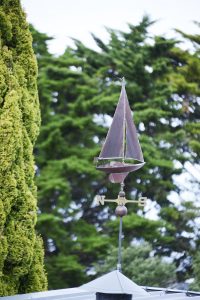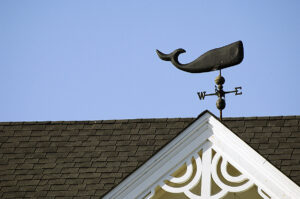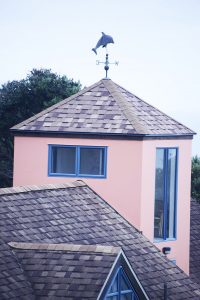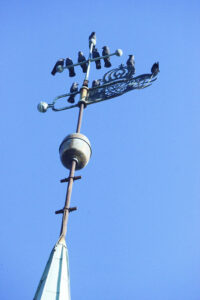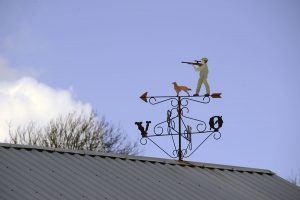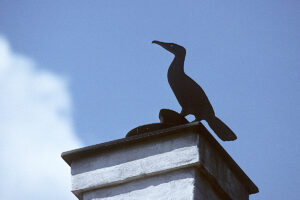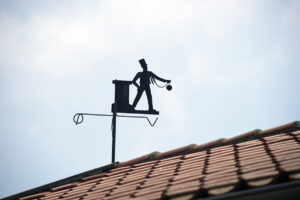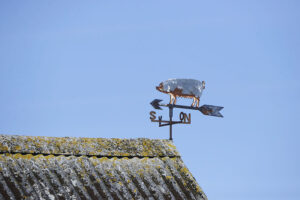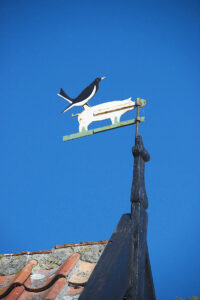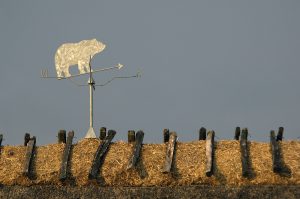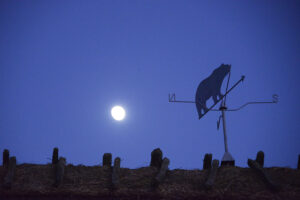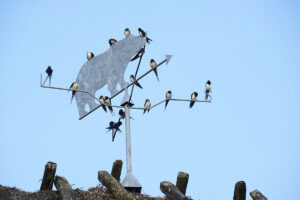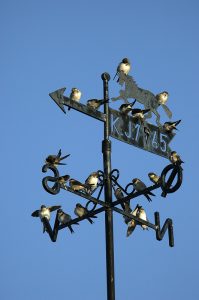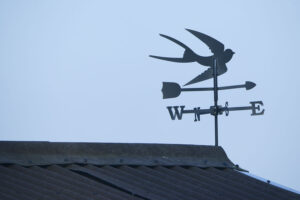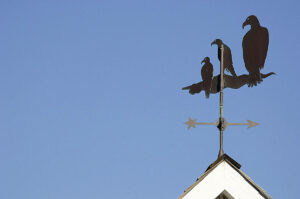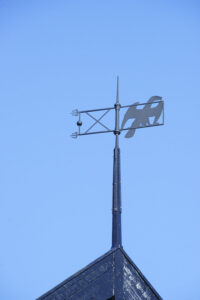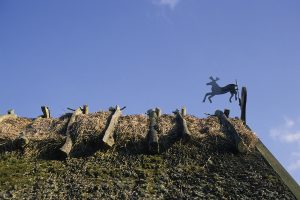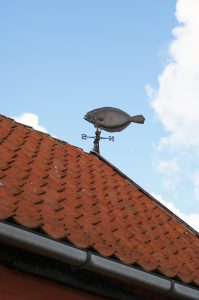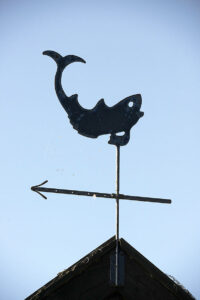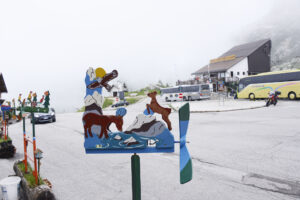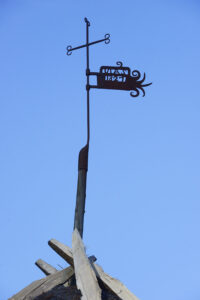Weather vanes
A weather vane, also called wind vane or weather cock, is an instrument for showing the direction of the wind. It is typically used as an architectural ornament on the highest point of a building.
The most common subject depicted on weather vanes is the cock, or rooster, giving rise to the term weather cock. In the 9th Century, the Pope decreed that the rooster should figure on weather vanes on church domes or steeples, possibly as a symbol of Christianity, referring to the prophecy of Jesus that Peter would deny him three times, before the rooster would crow on the morning after the Last Supper. (Source: thoughtco.com/weather-vane-history-3444409)
This weather vane, depicting a rooster, was observed on the island of Bornholm, Denmark. (Photo copyright © by Kaj Halberg)
This one was observed on a farm building in eastern Jutland, Denmark. (Photo copyright © by Kaj Halberg)
This one is found atop Källa Old Church, Öland, Sweden. (Photo copyright © by Kaj Halberg)
Naturally, cattle is often depicted on weather vanes. This one on Funen, Denmark, was overcome by ‘fatigue’. (Photo copyright © by Kaj Halberg)
Weather vane with a bull, observed near the village of Addit, central Jutland, Denmark. (Photo copyright © by Kaj Halberg)
Manor Jernit, near the town of Hammel, eastern Jutland, Denmark, was built in 1583 by nobleman Valdemar Parsberg, whose descendants owned it until the Danish-Swedish wars in the 1600s. In 1665, the ruined estate was purchased by treasurer Mogens Friis, who changed its name to Frijsenborg in 1672.
By 1763, the Friis lineage died out on the male line. However, Sophie Magdalene von Gram, widow after Baron Jens Krag-Juel-Vind, turned over the estate to her son, who bore the same name as his father. He added Frijs to his name, thus re-establishing the connection to the Frijs lineage.
When Christian Emil Krag-Juel-Vind-Frijs took over Frijsenborg in 1849, a glorious period of the manor began. In 1858, architect Ferdinand Meldahl planned alterations of the not very imposing Baroque building, and a gorgeous new Renaissance manor was completed in 1867. (Source: kroneborg.dk/279/frijsenborg)
In 1722, the estate on the island of Vorsø, Horsens Fjord, was sold to Søren Laursen for 2495 rix-dollars. However, he died already the following year, and his widow Johanne Møller sold the estate in 1725 for 1990 rix-dollars to “the very noble gentleman, Baron Friderich Krag of Stensballegaard, governor and adviser of His Royal Majesty’s honourable government.” This event marked the end of the island as an independent estate. (Source: M.R. Mikkelsen 1961. Vorsø. Træk af øens historie og natur. Østjysk Hjemstavn 26: 95-108)
In 1867, the estate Stensballegård – including Vorsø – was acquired by Count C.E. Krag-Juel-Vind-Frijs, who used it as a hunting ground, in which he and his retinue carried out parforce shootings on horse back, pursuing hares, foxes, and pheasants, which were released shortly before the shootings took place.
In 1928, the island was taken over by the Herluf Winge Foundation, and the major part of the island was protected as a nature reserve, described in depth on the page Nature reserve Vorsø.
In 1980, the only remaining evidence from the period, where Vorsø was owned by Manor Frijsenborg, was a weather vane on the roof of a large barn, depicting the so-called Frijsenborg Lion. (Photo copyright © by Kaj Halberg)
A popular theme on weather vanes is sailboats.
This one is from the islet of Christiansø, near Bornholm, Denmark. (Photo copyright © by Kaj Halberg)
Another sailboat, depicted on a weather vane in Auckland, New Zealand. (Photo copyright © by Kaj Halberg)
Another popular theme is whales.
This weather vane in the town of Mendocino, California, depicts a sperm whale (Physeter macrocephalus). (Photo copyright © by Kaj Halberg)
Dolphin, depicted on a weather vane near Muriwai Beach, New Zealand. (Photo copyright © by Kaj Halberg)
Vor Frue Kirke (‘Church of Our Lady’), Nyborg, Denmark, was initiated in 1389 during the reign of Queen Margrethe I (1353-1412). The weather vane, however, was added in 1703 during the reign of Frederik IV (1671-1730). His monogram is seen on the vane.
Jackdaws (Coloeus monedula), resting on the weather vane of Vor Frue Kirke, Nyborg. This bird is presented on the page Animals – Birds: Corvids. (Photo copyright © by Kaj Halberg)
“(…) there was a man who was a hunter, and his name was Hunter.” – This weather vane on Funen, Denmark, depicts a hunter and his dog. (Photo copyright © by Kaj Halberg)
In the 1800s, the great cormorant (Phalacrocorax carbo ssp. sinensis) was persecuted all over Europe, partly because it was competing with fishermen, partly because its guano destroyed the trees, in which it was breeding.
In Denmark, where it had been eradicated from almost the entire country, it was re-established as a breeding bird during the 1940s on Vorsø, a small island in Horsens Fjord, which had been declared a nature reserve in 1928. For a number of years, this island was home to the only colony of this bird in the entire country.
More about the cormorant and Vorsø is found on the page Nature Reserve Vorsø.
Naturally, a cormorant was chosen to adorn the weather vane on Vorsø. (Photo copyright © by Kaj Halberg)
This weather vane in the town of Melsted, Bornholm, Denmark, is suggestive of Hans Christian Andersen’s fairy tale The Shepherdess and the Chimney Sweep. (Photo copyright © by Kaj Halberg)
The population of domestic pigs in Denmark is around 13 million, so it would seem strange, if this animal did not appear on weather vanes.
This weather vane on a farm house on the islet of Nyord, near Møn, depicts a domestic pig. (Photo copyright © by Kaj Halberg)
This humorous weather vane in the town of Gudhjem, Bornholm, depicts a bird, sitting on a pig. (Photo copyright © by Kaj Halberg)
The owner of the weather vane in the pictures below, found on the island of Funen, Denmark, is named Bjørn (‘Bear’), so his choice of theme was obvious.
In the second picture from below, a male barn swallow (Hirundo rustica) chases away an intruder from this weather vane, on which his mate is sitting. Late in the summer, when young swallows have left their nest, many of them often gather on this ‘bear’ (bottom), in this case mostly barn swallows, and also two house martins (Delichon urbica). (Photos copyright © by Kaj Halberg)
Young barn swallows and house martins, gathered on a weather vane, depicting a horse, likewise on Funen, Denmark. (Photo copyright © by Kaj Halberg)
Yet another barn swallow, Funen, Denmark. (Photo copyright © by Kaj Halberg)
Due to widespread usage of DDT and other pesticides, the bald eagle (Haliaeetus leucocephalus) was largely eradicated from the Lower Fifty American States in the 1960s and 1970s. Today, fortunately, the population of this iconic bird is again increasing, among other places in California.
A proper name of this magnificent bird would be white-headed eagle, as it is not at all bald, but has white feathers on head and neck.
In California, the bald eagle is often depicted on weather vanes, in this case in the town of Mendocino. (Photo copyright © by Kaj Halberg)
A stylized eagle, Kalø, eastern Jutland, Denmark. (Photo copyright © by Kaj Halberg)
The moose (Alces alces) is very common in Sweden, and, naturally, it is often depicted on weather vanes, in this case in Himmelsberga, Öland. The moose is described in depth on the page Animals – Mammals: Deer. (Photo copyright © by Kaj Halberg)
Fishing is an important trade in Scandinavia, and, naturally, fish are sometimes depicted on weather vanes.
There are many fishermen in the town of Gudhjem, Bornholm, Denmark, making the choice of this flatfish as a weather vane quite appropriate. (Photo copyright © by Kaj Halberg)
This weather vane from Alvedsjö Bodar, Öland, Sweden, depicts an unidentified fish. (Photo copyright © by Kaj Halberg)
This weather vane, carved in wood, is for sale at the roadside, Passo Falzarego (2105 m), Dolomites, northern Italy. (Photo copyright © by Kaj Halberg)
It is up to the spectator, what this weather vane might depict, found on a building at Lillemølle, Ørbæk River, Funen, Denmark. (Photo copyright © by Kaj Halberg)
(Uploaded August 2018)
(Latest update August 2023)
